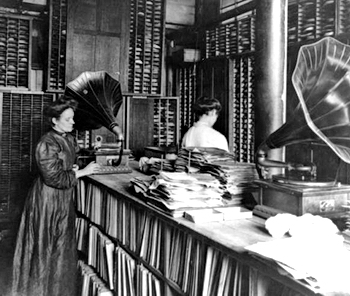|
The Canadian Connection - Part 2
by Steven C. Barr
Record matrix room, Berliner Gramophone Company, Montreal, 1910

|
|
Until 1904, the Berliner operations had enjoyed a monopoly on the disc business in Canada, with their only
competition coming from Edison cylinder machines and records. These were never manufactured in Canada, but
imported by the Canadian distributor, R.S. Williams and Sons Company, a venerable Toronto music firm. In
1904, however, competition became a fact, as Columbia opened a Canadian branch. Columbia recorded little, if
at all, in Canada, and it is not clear if even the pressing of records was done here at first, as most Columbia
records pressed in Canada used imported labels. They did, however, aggressively promote both records and
Graphophones in Canada, and were certainly pressing records here within a few years, taking advantage of the
patent agreements between Victor and Columbia in the U.S.
Even with both firms in the business, however, profits were ample. The phonograph industry was booming as
the first decade drew to an end; no home was complete without a phonograph. Further, Berliner acted
aggressively in the courts to maintain control, as their patents effectively prevented the manufacture or even
importation of lateral-cut records, and the few "outlaw" firms active in the U.S. did not see fit to enter the
Canadian market. Up until about 1912, Berliner and Columbia controlled sales of both records and machines. At
this point, while Berliner still continued to maintain the monopoly on record manufacture, new lines of
machines began to appear. It may be that gramophone-related patents had expired, or the firm may have had the
business sense to realize that more machines would serve to expand the market for records. From 1912 onward
it seemed that everyone was getting into the gramophone business, either manufacturing machines from assorted
parts obtained from jobbers or importing machines. Of these firms, only Vitaphone offered a line of records,
these being pressed by Columbia.
In 1914, World War I broke out and Canada was immediately involved on the side of the British. One of the
developments of this was an upsurge of patriotism, and both Berliner and Columbia took advantage of this by
offering lines of records from British sources or of Canadian material. Both firms may, in fact, have offered
such material earlier, but in a limited way and with minimal promotion. Both firms quickly offered lines of
records with flag-bedecked labels and patriotic material. Columbia even designated their line as the "Patriotic"
series, with numbers prefixed with "P" to so indicate. Columbia, as noted, did not record in Canada; sides on the
"P" series, and its R-4000 successor, were recorded in New York or London for Canadian issue. Berliner,
however, elected to start recording in Montreal (the firm had done so in early days, but later relied on Victor for
material) and launched a line of Canadian recordings bearing catalogue numbers in a 216000 series in 1916.
This effectively launched the actual recording industry in Canada.
In spite of the war, the business continued booming, and other U.S. firms began to look northward. By 1918,
virtually all of the major U.S. phonograph companies had established Canadian branches; the only company to
sell records, however, was Pathé, whose sapphire-ball recordings fell outside the Berliner patents. Pathé even
offered a line of records for the Canadian market, although it is not yet established if they were recorded here or
if the firm used Columbia's system. Many of these firms were, however, selling records in the U.S., using one of
the methods of vertical-cut or "hill-and-dale" recording. About 1918, these records began to appear in Canada,
some as imports, like Aeolian-Vocalion and the early vertical-cut Starr records, and others, such as Phonola,
sold U.S. recordings under a Canadian label (the Phonola firm had been involved with Okeh and related foreign
firms earlier, importing Odeon and Fonotipia records). The Canadian branch of Brunswick actually pressed and
sold records which were not available in the U.S. Their machines were equipped to play Pathé records, and the
firm obtained a license to use the Pathé system on their own line of discs. Apparently, either they chose to use
Canada as a test market, or Pathé elected not to have competition in the U.S. The records seem to be New York
recordings, however possibly made by Pathé themselves.
When the war ended, the record and phonograph industry boomed. Radio, as entertainment, was unknown, so
playing records was the only practical means of bringing music to the home (unless one had a large and talented
family). By 1919, in the U.S., some of the firms pressing vertical-cut records, eyeing the Victor/Columbia
market enviously, decided to take on these firms and market lateral-cut records playable on their machines.
Victor immediately launched legal action, but discovered that the essential patent had expired, leaving other
companies free to sell lateral recordings. Needless to say, virtually all of the companies did so. As the U.S. firms
launched lines of lateral or "needle-cut" records, they became available in Canada as well.
Herbert Berliner, in all probability, saw the "handwriting on the wall" in 1918 when Pathé, Brunswick, Phonola,
Vocalion and others entered the record field. As the war ended he set out to establish a new firm, and early in
1919 established the Compo Company on the outskirts of Montreal, offering to press records for other firms.
Both Starr (Gennett) and Phonola became Compo customers, which offered Berliner connections with Okeh and
Gennett. As well, Berliner was apparently recording for these firms in the Victor studios, as Gennett offered a
500 series of Canadian recordings in late 1919, some two years before Compo would have their own studios.
Berliner, as well, was recording extensively for his own His Master's Voice 216000 series; at first this was to
supplement a much reduced output from Victor after the U.S. entered the war, but Montreal recordings all but
replaced Victor sides in the black-label popular series.
|